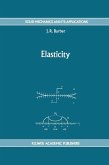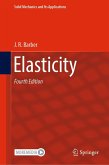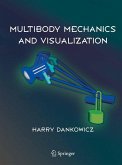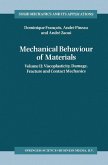This is a first year graduate textbook in Linear Elasticity. It is written with the practical engineering reader in mind, dependence on previous knowledge of solid mechanics, continuum mechanics or mathematics being minimized. Emphasis is placed on engineering applications of elasticity and examples are generally worked through to final expressions for the stress and displacement fields in order to explore the engineering consequences of the results.
The topics covered are chosen with a view to modern research applications in fracture mechanics, composite materials, tribology and numerical methods. Thus, significant attention is given to crack and contact problems, problems involving interfaces between dissimilar media, thermoelasticity, singular asymptotic stress fields and three-dimensional problems.
This third edition includes new chapters on complex variable methods, variational methods and three-dimensional solutions for the prismatic bar. Other detailed changes have been made throughout the work, many suggested by users of earlier editions.
The new edition includes over 300 end-of-chapter problems, expressed wherever possible in the form they would arise in engineering - i.e. as a body of a given geometry subjected to prescribed loading - instead of inviting the student to 'verify' that a given candidate stress function is appropriate to the problem. Solution of these problems is considerably facilitated by the use of modern symbolic mathematical languages such as Maple and Mathematica. Electronic files and hints on this method of solution, as well as further supplementary software are available for download via the webpage for this volume on www.springer.com.
The topics covered are chosen with a view to modern research applications in fracture mechanics, composite materials, tribology and numerical methods. Thus, significant attention is given to crack and contact problems, problems involving interfaces between dissimilar media, thermoelasticity, singular asymptotic stress fields and three-dimensional problems.
This third edition includes new chapters on complex variable methods, variational methods and three-dimensional solutions for the prismatic bar. Other detailed changes have been made throughout the work, many suggested by users of earlier editions.
The new edition includes over 300 end-of-chapter problems, expressed wherever possible in the form they would arise in engineering - i.e. as a body of a given geometry subjected to prescribed loading - instead of inviting the student to 'verify' that a given candidate stress function is appropriate to the problem. Solution of these problems is considerably facilitated by the use of modern symbolic mathematical languages such as Maple and Mathematica. Electronic files and hints on this method of solution, as well as further supplementary software are available for download via the webpage for this volume on www.springer.com.
Dieser Download kann aus rechtlichen Gründen nur mit Rechnungsadresse in A, B, BG, CY, CZ, D, DK, EW, E, FIN, F, GR, HR, H, IRL, I, LT, L, LR, M, NL, PL, P, R, S, SLO, SK ausgeliefert werden.
'...this book is a very good addition to the available literature on elasticity and can be used as a textbook for the first year graduate course on linear elasticity.' Applied Mechanics Reviews, 45:12 (1992)
'...this book is a very good addition to the available literature on elasticity and can be used as a textbook for the first year graduate course on linear elasticity.' Applied Mechanics Reviews, 45:12 (1992)
From the reviews of the second edition:
"The second edition includes new three chapters on antiplane stress systems, Saint-Venant torsion and bending and an expanded section on three-dimensional problems in spherical and cylindrical coordination systems ... . The topics covered are chosen with a view to modern research applications in fracture mechanics, composite materials, tribology and numerical methods. ... Most of the text should be readily intelligible to a reader with an undergraduate background of one or two courses in elementary mechanics of materials and a rudimentary knowledge of partial differentiation." (Vasily A. Chernecky, Zentralblatt MATH, Vol. 1068 (19), 2005)
"The second edition includes new three chapters on antiplane stress systems, Saint-Venant torsion and bending and an expanded section on three-dimensional problems in spherical and cylindrical coordination systems ... . The topics covered are chosen with a view to modern research applications in fracture mechanics, composite materials, tribology and numerical methods. ... Most of the text should be readily intelligible to a reader with an undergraduate background of one or two courses in elementary mechanics of materials and a rudimentary knowledge of partial differentiation." (Vasily A. Chernecky, Zentralblatt MATH, Vol. 1068 (19), 2005)









